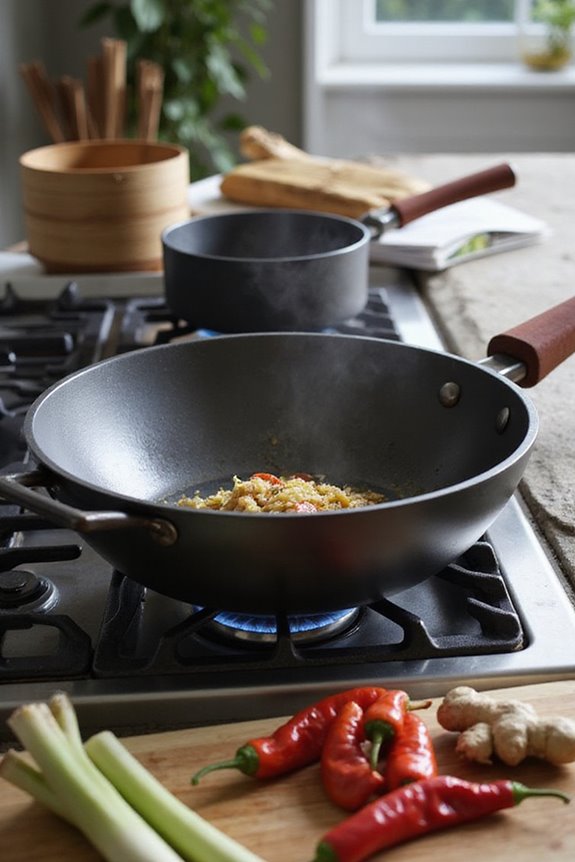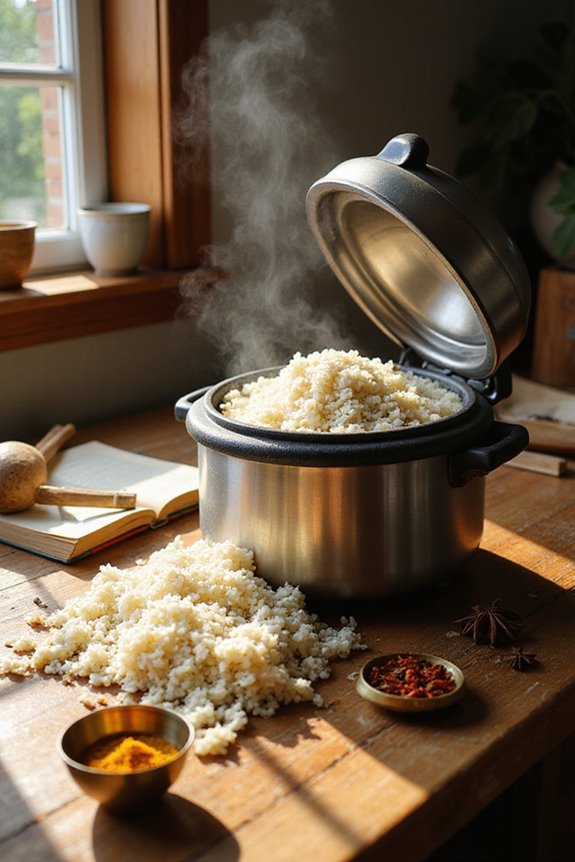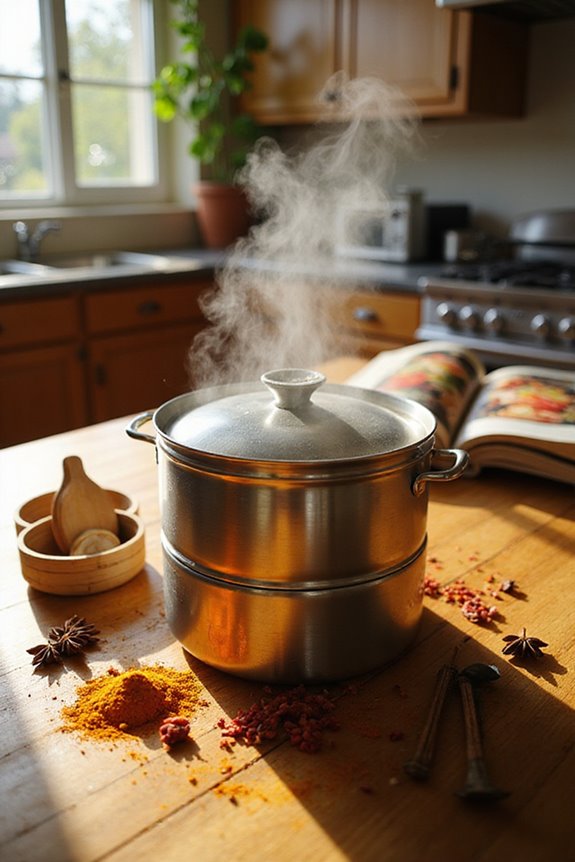Absolutely, we can use a wok for deep frying! It’s a delightful experience with its high, sloping sides that splash less oil all over our kitchen. Plus, it requires 30-33% less oil, making it a budget-friendly option. We can easily fry bite-sized goodies without overcrowding, and the heat distribution is fantastic for crispy results. So grab your favorite wok and get ready for a magical frying adventure! There’s more to discover, including tips for the best results!
Key Takeaways
- Yes, a wok can be used for deep frying due to its conical shape, requiring 30-33% less oil than traditional pans.
- The high, sloping walls of a wok contain splatters, keeping your kitchen cleaner while frying.
- Woks offer efficient heat distribution, allowing food to cook evenly and quickly at optimal oil temperatures.
- Careful monitoring of oil temperature is essential for safety, using a probe thermometer to prevent overheating.
- Stability can be improved with a wok ring, and always handle hot oil carefully to avoid spills and burns.
Advantages of Using a Wok for Deep Frying
When it comes to deep frying, using a wok is like throwing a magical party for your food! 🥳 Not only does it offer a delightful cooking experience, but it also brings some impressive advantages that’ll make you want to ditch your old frying pans.
Oil Efficiency: Woks need about 33% less oil, minimizing waste and cleanup. Less oil absorption means lighter, crispy bites!
Splatter Control: Those high, curved sides catch splatters and keep our kitchen safe and tidy.
Heat Distribution: Wok design provides concentrated heat, speeding up frying.
Ease of Handling: The wide shape helps us maneuver food easily without overcrowding.
Additionally, using a wok for deep frying improves heat distribution efficiency, which results in evenly cooked food and enhances overall texture.
Considerations for Wok Shape and Design

To maximize our wok’s potential for deep frying, we need to contemplate its unique shape and design. The conical shape allows for a delightful pool of hot oil at the bottom, using 25-30% less oil than traditional pans! This means we can cook more exciting bite-sized foods like chicken nuggets or calamari without overcrowding. Those high, sloping walls aren’t just stylish; they keep our kitchen cleaner by containing splatters while we fry. Remember, using the right wok dimensions is essential—fill it with about 3-4 inches of oil for magical results. By harnessing our wok’s shape, we can elevate our cooking techniques for crispy, golden treats everyone will love. Carbon steel woks excel at heat conductivity, ensuring our oil reaches the desired temperature quickly. Let’s explore deep frying together!
Temperature Control and Safety

Temperature control is key to achieving crispy, golden treats when deep frying in our woks, especially during the busy holiday season when we’re enthusiastic to impress our friends and family!
To keep our oil in the perfect range of 350°F to 380°F, let’s use a reliable probe thermometer. Since woks can experience temperature fluctuations, we’ll need to check often, as they heat quickly! Remember, if the oil starts smoking, we’ve overheated it; time to reduce the heat or take a break!
Here are glittering tips to maintain safety:
- Always keep a fitted lid close by for emergency smothering.
- Never leave hot oil unattended—imagine that magic bubbling away unattended!
With care and attention, our deep frying will dazzle everyone! Additionally, using a transparent lid will allow you to monitor the temperature and cooking progress without losing heat.
Oil Usage Efficiency

Using a wok for deep frying isn’t just about achieving crispy delights; it’s also a smart way to be efficient with oil! With its sloped sides, a wok requires about 30-33% less oil than traditional pots. Here’s how it makes oil conservation magical:
- Shallower Depth: We can fry our favorite snacks without drowning them in oil!
- Quick Heating: Woks heat up fast, keeping oil usage lower and costs down.
- Less Splatter: The tall sides keep our kitchen cleaner—who wants to mop up after frying?
- Easy Reuse: With less oil, reusing and filtering is a breeze. Additionally, using a wok provides better temperature control which enhances overall frying efficiency.
Practical Tips for Deep Frying in a Wok

When it comes to deep frying in a wok, we’ve got some delightful tips to guarantee our cooking adventure is both fun and safe! First, let’s monitor our oil temperature—aim for around 350°F to 375°F with a thermometer. Dry those food types thoroughly; it’s a magical way to minimize splatter.
- Add each piece one at a time, ’cause nobody likes clumpy fries!
- Stay in the kitchen; constant supervision is critical, just like checking Santa’s list twice.
Let’s fill our wok halfway with oil, about 3 inches deep, for safe frying. Remember, no overcrowding! With these frying techniques, our crispy creations will be a holiday hit, and we’ll feel like culinary geniuses. Additionally, consider using a carbon steel wok as it ensures even heat distribution for better frying results. Happy frying, everyone!
Limitations and Challenges
While we’ve shared some delightful tips for deep frying in a wok, it’s time to explore the limitations and challenges that can pop up during our culinary adventures.
- Oil Quantity: Woks need a larger volume of oil, which can be expensive and messy. Plus, more oil means more splatters, and nobody wants to be the one with a sizzling surprise!
- Temperature Control: Without built-in thermostats, staying consistent can be tricky. We’ll want to keep a watchful eye on our oil temperature for the best frying techniques.
- Safety Concerns: The open design can lead to hot oil spills, increasing the risk of burns. It’s all about careful handling! Plus, using a wok ring can enhance stability and reduce the risk of tipping during high-heat frying, featuring a non-slip design for better control.
Let’s embrace these challenges together and whip up something magical!
Best Types of Woks for Deep Frying
Finding the right type of wok for deep frying can make a world of difference in our culinary journey! When we choose carbon steel as our wok material, we’re opting for a magical cooking experience. It heats oil quickly and evenly, giving our fried goodies delightful texture. The best wok sizes for home frying are around 12–14 inches in diameter, letting us create a cozy oil pool for frying.
Flat-bottom woks are ideal for our kitchen stoves, offering stability and easy temperature control. Plus, with a primary handle and a helper handle, we’ll easily maneuver our creations without spills. So, let’s gear up, gather our ingredients, and get frying—we’re going to make some delicious memories together!
Cleaning and Maintaining Your Wok After Frying
After we’ve dried it thoroughly, let’s do some seasoning maintenance! Heat it up, apply a thin layer of oil, and watch it transform. For sticky spots? A sprinkle of salt and oil works wonders—like magic! Let’s make sure to store our treasure in a dry place. Happy cooking, everyone! 🥘✨
Frequently Asked Questions
Can I Deep Fry Frozen Foods in a Wok?
Sure, we can definitely deep fry frozen foods in a wok! Just remember to remove excess ice, maintain oil temperature, and handle everything safely. Together, we’ll enjoy crispy, delicious results while having a blast in the kitchen!
What Types of Oil Are Best for Deep Frying in a Wok?
When considering the best oils for deep frying in a wok, we often find peanut oil and sunflower oil rise to the top. They offer great smoke points and enhance our delicious culinary creations together!
How Does Frying in a Wok Differ From Frying in a Deep Fryer?
Isn’t it amusing how frying techniques might seem universal? Yet, we find that using a wok enhances heat distribution, allowing us to achieve crispy results efficiently. So, let’s embrace our culinary adventure together!
Can I Use a Wok on an Induction Stovetop for Deep Frying?
Sure, we can use a wok on an induction stovetop for deep frying, as long as it’s made of ferromagnetic materials like carbon steel or cast iron. Let’s explore the best options together!
What’s the Ideal Oil Temperature for Deep Frying in a Wok?
Imagine frying crispy spring rolls perfectly. We’ve learned that the ideal temperature for deep frying is between 350ºF and 375ºF. Mastering these frying techniques guarantees our food comes out beautifully cooked and delectably crisp every time.





